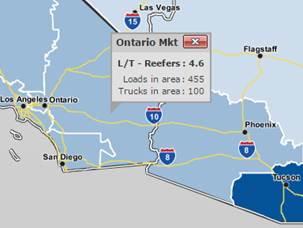California needs rain, and El Niño has brought bring plenty – along with flooding and landslides. For crops, the weather is a double-edged sword. On one side, it provides needed moisture, but it also complicates planting and harvest efforts.
California has experienced record rainfall for the past two months, and the ground simply can’t absorb any more water. The wet conditions and flooding are expected to cause delay or damage to the state’s primary crops.
El Niño Is a Double-Edged Sword
The current concern is spring vegetables, because January rain disrupted planting season. Much of the nation’s spring crop comes from the coastal California valleys, in the areas surrounding Salinas and Santa Maria. Harvests start in early April, with lettuce.
Right now, the southern desert areas of California and Arizona are picking up. The Hot Market Map detail, below, shows outbound load and truck posts in the Ontario, CA market on February 8th. The Imperial Valley is picking up, as demand increases for that agricultural region east of Ontario. At the moment, however, the Tucson market is currently the strongest area, including the border crossing at Nogales, AZ.

My musician friends recently played a number of gigs in Northern California. They report that the sheer number of fields experiencing flooding was amazing. Only in California can you simultaneously have a severe drought alongside flooding and other serious consequences of too much water.
The outlook is for more rain this spring, with a transition this summer to La Niña conditions. That will produce drier weather and likely a resumption of the drought issues. In the meantime, the rain is a mixed blessing.
Weather patterns have a profound effect on road conditions and cargo availability. Keep up with the resulting changes in demand and rates, by lane and equipment type, with Hot Market Maps, available in DAT Power load board and DAT RateView.


